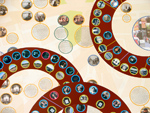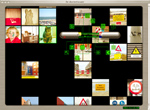
|
Day Two: From Cultural Research to Design Daniela
Paes Leão Presentation At the evening, Daniela Paes Leão discussed on two of her projects: the first one was a project she developed in the slums of Jerusalem in 2003, and another one is the project in the new suburban neighborhood of Amsterdam in 2006. Paes Leão experience is precious for a new understanding of the relationship between cultural research, art and design. In the first project, video was an important media in developing relationship with the inhabitants. Immigration had always be one of the main subjects of Paes Leão investigations. She has a great interest in how people survive and re-invent new ways of living in another culture. The first project was situated at an immigrant neighborhood in Jerusalem. Paes Leão was much concerned about the lack of public life there. So she decided to give the immigrants cameras to film their own lives; therefore the residents could verbalize and visualize their lives. Paes Leão said that the camera was especially crucial at that situation as she did not speak the language of those immigrants. Paes Leão did the second project while she was the artist-in-residence at The Blue House. IJburg, which is a new community without history, or in Paes Leão words: a “non-place”. She collected some the images about the histories of the residents, and then connected them in a website. The website serves as an online database of the history of residents of IJburg. Paes Leão said that the website could also let people to compare the expectations between the residents and those of the professionals who planned the whole place. At last Paes Leão also added that the website is designed deliberately to be not pointing to any certain point. So every visit to the website would be like a walk in the city. People would not get the instantaneous responses like they usually do on the internet. Paes Leão projects shed light on a new perspective of cultural research and design. Every art work and design has to go through the process of research, but research is often thought as a supporting or initial stage of the whole process. This two cases shows that researches could take a more frontline role. For Paes Leão's projects, the researches do not only serve the purpose of researchers/artists, it could be a chance for empowering the participants. So the research itself could be a design for connecting the community.
Biography Daniela Paes Leão (Coimbra, Portugal, 1974) graduated in 1999 at the Faculty of Fine Arts of the University of Porto. She works as an artist and a filmmaker, developing creative projects in the crossing of aesthetics with sociology, anthropology, and other disciplines. In 2002 she went to Italy on the invitation of the Pistoletto Foundation to develop a project with a Moroccan community. After that she went to the Netherlands, where she lives and works at this moment. Daniela has been working with communities since 2001. Her first project was about an old folkdance group in the Portuguese city Porto. She found interest in the way they toured through the whole country in order to show their performance; they had to travel in order to exist. Soon after that, like them, she became an immigrant as well. Immigration turned out to be one of the main subjects of her investigations. She developed projects in different countries, such as Italy, Israel and Holland, where she investigated how people survive and re-invent new ways of living in another culture, and how they create their own cultural enclaves. Recently she was the artist-in-residence at The Blue House, Amsterdam, where she created an on-line database of the history of residents of IJburg, a community that starts from scratch and without a history of its own. |
| X Close | |

